contents area
Press Release
detail content area
- Date2020-04-01 19:54
- Update2020-04-01 20:04
- DivisionDivision of Risk assessment and International cooperation
- Tel043-719-7556
Updates on COVID-19 in Republic of Korea
1 April 2020
○ As of 0:00, 1 April 2020, a total of 9,887 cases (including 560 imported cases) have been confirmed, of which 5,567 cases have been discharged from isolation. Newly confirmed cases are 101 in total.
[Table 1. Total confirmed and suspected cases]
|
Period (since 3 Jan) |
Total |
Tested positive |
Being tested |
Tested negative |
|||
|
Confirmed |
Discharged |
Isolated |
Deceased |
||||
|
As of 0:00 31 March (Tues) |
410,564 |
9,786 |
5,408 |
4,216 |
162 |
16,892 |
383,886 |
|
As of 0:00 1 April (Wed) |
421,547 |
9,887 |
5,567 |
4,155 |
165 |
16,585 |
395,075 |
|
Difference |
10,983 |
101 |
159 |
-61 |
3 |
-307 |
11,189 |
○ Epidemiological links have been found for 83.5% of the total cases; 10.8% are either under investigation or sporadic cases. More details on the epidemiological links within each province or city are shown in Table 2.
○ From Uijeongbu St. Mary’s Hospital in Gyeonggi Province, 6 additional cases were confirmed. In total, 13 cases (patients = 5 (including 1 death); staff/workers = 6; family of patient = 2) have been confirmed since 29 March. Further epidemiological investigation is underway.
○ From Asan Medical Center is Songpa-gu, Seoul, 1 inpatient has been confirmed with COVID-19. Epidemiological investigation is underway. The patient had visited Uijeongbu St. Mary’s Hospital during 25-26 March. Investigation into the places visited by the patient and contact tracing is underway. Healthcare staff and family/caregivers who had come in contact with the confirmed case have been placed under self-quarantine. The 43 inpatients will be placed in cohort quarantine.
○ From Manmin Central Church in Guro-gu, Seoul, 8 additional cases were confirmed while under self-quarantine. In total, 41 confirmed cases have been confirmed since 25 March. Investigation into places visited by new confirmed cases and contact tracing are underway.
○ From Hansarang Convalescent Hospital in Seo-gu, Daegu, 11 additional cases were confirmed. From two healthcare institutions in Dalseong-gun, Daegu, 4 additional cases were confirmed (Daesil Convalescent Hospital = 3; Second Mi-Ju Hospital = 1).
○ From the investigation into all caregivers working at hospital-grade institutions in Daegu, 2 cases have been confirmed.
○ Analysis of chains of transmission of confirmed cases within the last 2 weeks have found that 35.0% are imported cases; 34.9% are hospitals/nursing homes; 6.3% are other clusters; and 6.6% are under investigation.
Imported cases in Korea (as of 0:00, 1 April 2020)
|
|
Total |
Region/Country |
Where confirmed |
Nationality |
||||||
|
China |
Asia ex-China |
Europe |
America |
Africa |
Airport |
Community |
Korean |
Other |
||
|
New |
36 |
0 |
4 |
14 |
17 |
1 |
7 |
29 |
33 |
3 |
|
Total |
560 |
17 |
64 |
298 |
178 |
3 |
224 |
336 |
514 |
46 |
|
(3.0%) |
(11.4%) |
(53.2%) |
(31.8%) |
(0.5%) |
(40.0%) |
(60.0%) |
(91.8%) |
(8.2%) |
||
* Figures may change based on findings from ongoing local epidemiological investigation efforts.
○ Since 22 March, the number of inbound travelers have been under 10,000 per day. The number is expected to decrease with the implementation of mandatory 14-day quarantine for all travelers (including short-term visitors) effective starting today.
○ Due to the rise in COVID-19 cases in many countries around the world and the rise in the number of imported cases from overseas, starting 0:00 of 1 April, stronger infectious disease control measures will be applied for travelers arriving in from overseas. All Koreans and foreigners residing in Korea arriving from all overseas countries will be subject to self-quarantine for 14 days upon entry. Foreigners on a short-term visit will be subject to facility quarantine and pay for the use of the facility. Exceptions to self-quarantine will be applied only for limited cases with valid reasons for exemption (such as a matter of public/national interest). The exempt persons will still be subject to testing and active monitoring.
○ Persons arriving from overseas should return home straight after arriving at the airport. They should travel in their own vehicle or designated airport limousine bus or designated KTX train (reserved specifically for this purpose). They are required to sanitize their hands and wear a facemask during movement.
○ The persons under self-quarantine are required to follow the self-quarantine guidelines provided. They must not share their utensils, towels and other personal belongings with their family, refrain from coming in contact with family members, roommates, or cohabitants. Family members, roommates, or cohabitants should wear a facemask and keep 2 meter distance from the person under self-quarantine, ventilate the living space frequently, and clean all frequently touched surfaces often. If they notice suspected symptoms develop (fever, cough, sore throat, muscle pain, shortness of breath, etc.) they must contact the designated public official or use the self-quarantine app to notify their symptoms and go to a screening center to be tested.
○ All persons who arrived in Korea from overseas within the last 14 days, even if they are not subject to mandatory self-quarantine, should stay home as much as possible, minimize contact with other people, maintain strict personal hygiene (washing hands, covering sneezes/coughs, etc.) to prevent infecting family members or those sharing living spaces, and call to ask a local public health center, KCDC call center (1339) or local call centers (area code + 120) to be tested at a screening center, and disclose their international travel history to the healthcare professionals.
○ The Korean government is promoting the Enhanced Social Distancing campaign from 22 March to 5 April. The KCDC is advising limited operation of high-risk facilities, businesses and sectors and advising people to stay home and refrain from going outside, and minimize contact with coworkers at work. The KCDC again urged people to continue to refrain from attending religious gathering, going to indoor fitness or sports facilities, or otherwise engaging in activities that make it easy to come in close contact with other people in an enclosed space, and maintain good personal hygiene including washing hands and covering coughs/sneezes.
|
Call to actions for all citizens
① Cancel or postpone all non-essential gatherings, dining out, social events, and travel plans. * There have been numerous reports overseas of transmission by eating together. All meetings and events involving sharing a meal should especially be postponed or canceled.
② If you have fever, cough, sore throat, muscle pain, or other respiratory symptoms, do not go to work. Stay home and get sufficient rest.
③ Avoid leaving home except to purchase necessities, to get medical care, or to go to work.
④ Avoid handshakes and other forms of physical contact. Keep a 2-meter distance from each other.
⑤ Wash your hands, cover up your sneezes/coughs, and generally maintain strict personal hygiene.
⑥ Disinfect and ventilate your space every day. |
○ A recent survey found that over 90% of Koreans participated in following infectious disease prevention measures and social distancing. The KCDC expressed deep appreciation for the solidarity and civic participation shown by the Korean people in this time of crisis.
○ The survey asked 1,000 men and women across the country, “How much did you participate in social distancing during the last 7 days?” And 96% of respondents said they “refrained from going outside”; 95% said they refrained from using publicly used venues such as libraries and cafes; 92.9% said they did not attend social or religious gatherings; 69.9% responded that they are meeting people face-to-face 50% less than before.
○ On the other hand, to the question “Do you have someone you can ask for advice or lean on when you need to make an important decision because of COVID-19?”, 80.5% responded “Yes” (19.5% “No”). To the question “Do you have someone you can contact and confide in when you are alone because of self-quarantine or social distancing?” 90.5% responded “Yes” (9.5% “No”).
○ Acknowledging that prolonged social distancing can cause many people to feel a deepened sense of isolation and alienation, the KCDC reminded people that reaching out to friends and neighbors to show encouragement and support can go a long way toward helping people overcome a crisis and minimizing the psychological trauma of our society.
○ The KCDC expressed thanks for the hard work and dedication of the healthcare professionals working day and night at the forefront of the fight against COVID-19 and stressed that it will do its best to protect the healthcare professionals at the front line.
[Table 2: Regional distribution and epidemiological links of the confirmed cases]
|
Region |
Confirmed cases |
Other major clusters |
||||||||
|
Total |
Imported cases |
Clusters |
Other* |
New cases |
||||||
|
Sub- total |
Shin- cheonji |
Small clusters |
Contacts of confirmed cases |
Imported cases |
||||||
|
Seoul |
474 |
127 |
310 |
7 |
228 |
37 |
38 |
37 |
24 |
Guro-gu call center (97), Dong-an Church-PC Cafe (20), Manmin Central Church (35), etc. |
|
Busan |
122 |
12 |
80 |
12 |
50 |
18 |
0 |
30 |
3 |
Onchun Church (32), Suyeong-gu Kindergarten (5), etc. |
|
Daegu |
6,704 |
5 |
5,961 |
4,477 |
563 |
918 |
3 |
738 |
20 |
Second Mi-Ju Hospital (135), Hansarang Convalescent Hospital (121), Daesil Convalescent Hospital (94), etc. |
|
Incheon |
69 |
25 |
40 |
2 |
31 |
4 |
3 |
4 |
5 |
Guro-gu call center (20), etc. |
|
Gwangju |
24 |
6 |
15 |
9 |
0 |
3 |
3 |
3 |
4 |
|
|
Daejeon |
36 |
6 |
21 |
2 |
11 |
8 |
0 |
9 |
0 |
Korea Forest Engineer Institute (3), etc. |
|
Ulsan |
39 |
8 |
24 |
16 |
1 |
4 |
3 |
7 |
0 |
|
|
Sejong |
46 |
3 |
42 |
1 |
38 |
3 |
0 |
1 |
0 |
Ministry of Oceans and Fisheries (30), gym facilities (8) |
|
Gyeonggi |
499 |
96 |
359 |
29 |
251 |
61 |
18 |
44 |
23 |
Grace River Church in Seongnam (72), Guro-gu call center-Bucheon SaengMyeongSu Church (48), Uijeongbu St. Mary’s Hospital, etc. |
|
Gangwon |
38 |
7 |
23 |
17 |
5 |
1 |
0 |
8 |
2 |
Apartments in Wonju City (3), etc. |
|
Chung- |
44 |
4 |
31 |
5 |
11 |
13 |
2 |
9 |
0 |
Goesan-gun Jangyeon-myeon (11) |
|
Chung- |
131 |
8 |
114 |
0 |
112 |
2 |
0 |
9 |
3 |
Gym facilities in Cheonan (103), research center in Seosan (8), etc. |
|
Jeon- buk |
14 |
6 |
1 |
1 |
0 |
0 |
0 |
7 |
1 |
|
|
Jeon- |
12 |
4 |
6 |
1 |
2 |
2 |
1 |
2 |
3 |
Manmin Central Church (2) |
|
Gyeong- |
1,302 |
5 |
1,164 |
559 |
411 |
193 |
1 |
133 |
2 |
Cheongdo Daenam Hospital (120), Bonghwa Pureun Nursing Home (68), pilgrimage to Israel (49), Gyeongsan Seo Convalescent Hospital (46), etc. |
|
Gyeong- |
100 |
9 |
72 |
32 |
35 |
5 |
0 |
19 |
4 |
Geochang Church (10), Geochang Woongyang-myeon (8), etc. |
|
Jeju |
9 |
5 |
0 |
0 |
0 |
0 |
0 |
4 |
0 |
|
|
Airport |
224 |
224 |
0 |
0 |
0 |
0 |
0 |
0 |
7 |
|
|
Total |
9,887 |
560 |
8,260 |
5,171 |
1,745 |
1,272 |
72 |
1,067 |
101 |
|
|
(5.7) |
(83.5) |
(52.3) |
(17.6) |
(12.9) |
(0.7) |
(10.8) |
||||
|
* Not classified into a cluster or under investigation ※ The interim classification is based on the reporting location, which may change depending on further epidemiological investigation. |
||||||||||
○ Nationwide case trends:
[Figures 1-2: Daily and total confirmed cases and their status]
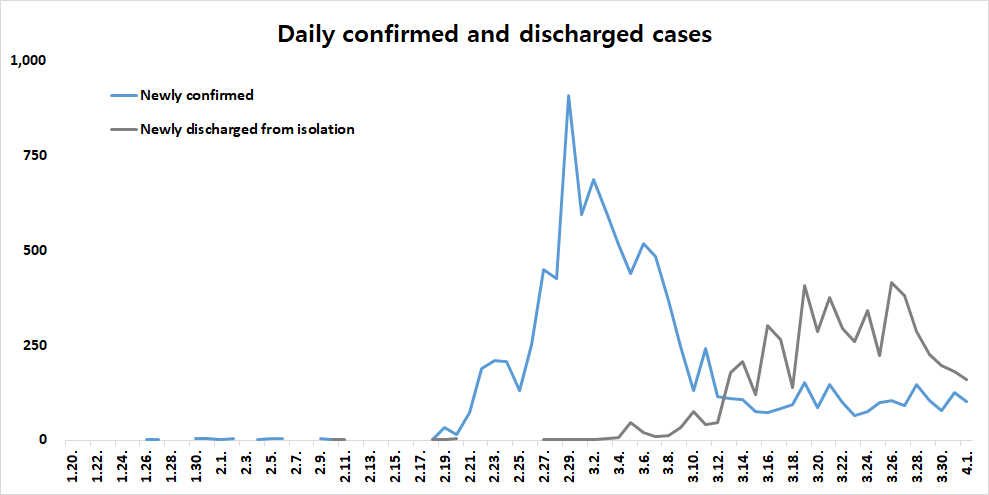
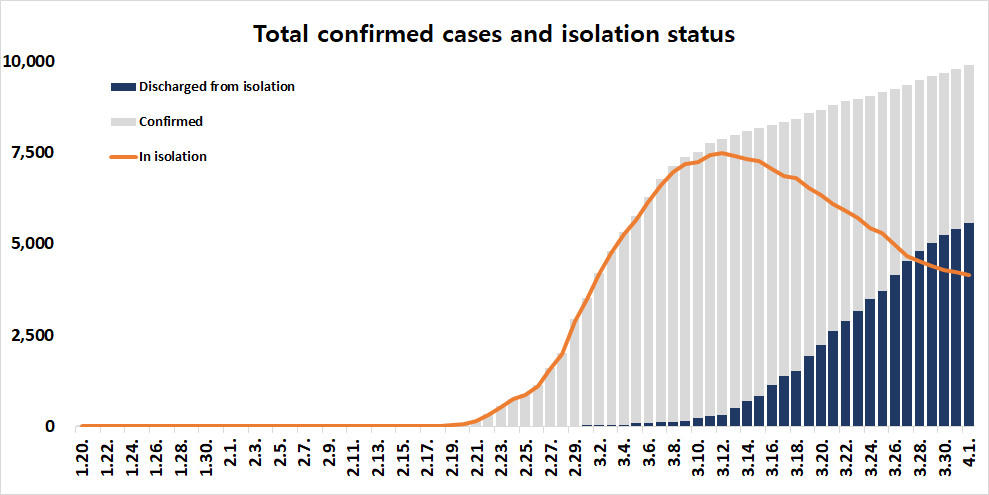
[Figure 3: Distribution of confirmed cases based on location reported]
* Refer to attachment
○ Case distribution data:
[Table 3: Confirmed cases by region]
|
|
Total |
City |
||||||||||||||||
|
Seoul |
Busan |
Daegu |
Incheon |
Gwangju |
Daejeon |
Ulsan |
Sejong |
|||||||||||
|
Isolated |
4,155 |
357 |
32 |
2,519 |
50 |
10 |
18 |
18 |
34 |
|||||||||
|
Discharged |
5,567 |
117 |
87 |
4,070 |
19 |
14 |
18 |
20 |
12 |
|||||||||
|
Deceased |
165 |
0 |
3 |
115 |
0 |
0 |
0 |
1 |
0 |
|||||||||
|
Subtotal |
9,887 |
474 |
122 |
6,704 |
69 |
24 |
36 |
39 |
46 |
|||||||||
|
(Change) |
(101) |
(24) |
(3) |
(20) |
(5) |
(4) |
- |
- |
- |
|||||||||
|
|
Province |
Other |
||||||||||||||||
|
Gyeonggi |
Gangwon |
Chung-buk |
Chung- nam |
Jeon- buk |
Jeon- nam |
Gyeong- buk |
Gyeong-nam |
Jeju |
Airport screening |
|||||||||
|
Isolated |
322 |
14 |
21 |
40 |
7 |
9 |
441 |
33 |
6 |
224 |
||||||||
|
Discharged |
171 |
23 |
23 |
91 |
7 |
3 |
822 |
67 |
3 |
0 |
||||||||
|
Deceased |
6 |
1 |
0 |
0 |
0 |
0 |
39 |
0 |
0 |
0 |
||||||||
|
Subtotal |
499 |
38 |
44 |
131 |
14 |
12 |
1,302 |
100 |
9 |
224 |
||||||||
|
(Change) |
(23) |
(2) |
- |
(3) |
(1) |
(3) |
(2) |
(4) |
- |
(7) |
||||||||
|
|
||||||||||||||||||
[Table 4: Case distribution and incidence rate by region]
|
Region |
# of cases |
(%) |
Incidence rate (per 0.1M) |
Region |
# of cases |
(%) |
Incidence rate (per 0.1M) |
|
Seoul |
474 |
(4.79) |
4.87 |
Gyeonggi |
499 |
(5.05) |
3.77 |
|
Busan |
122 |
(1.23) |
3.58 |
Gangwon |
38 |
(0.38) |
2.47 |
|
Daegu |
6,704 |
(67.81) |
275.15 |
Chungbuk |
44 |
(0.45) |
2.75 |
|
Incheon |
69 |
(0.70) |
2.33 |
Chungnam |
131 |
(1.32) |
6.17 |
|
Gwangju |
24 |
(0.24) |
1.65 |
Jeonbuk |
14 |
(0.14) |
0.77 |
|
Daejeon |
36 |
(0.36) |
2.44 |
Jeonnam |
12 |
(0.12) |
0.64 |
|
Ulsan |
39 |
(0.39) |
3.40 |
Gyeongbuk |
1,302 |
(13.17) |
48.90 |
|
Sejong |
46 |
(0.47) |
13.44 |
Gyeongnam |
100 |
(1.01) |
2.98 |
|
Airport Screening |
224 |
(2.27) |
- |
Jeju |
9 |
(0.09) |
1.34 |
|
|
|
|
|
Total |
9,887 |
(100) |
19.07 |
[Figures 4-7: Daily case trends by region (Daegu, Gyeongbuk, Seoul, Gyeonggi)]
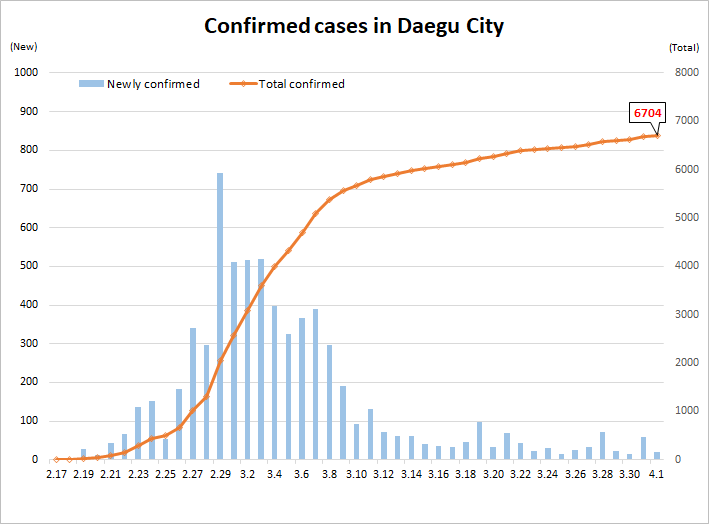
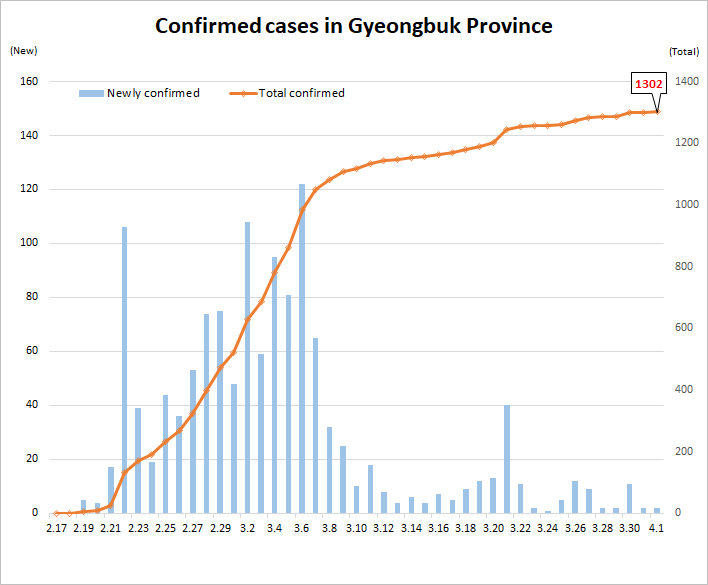
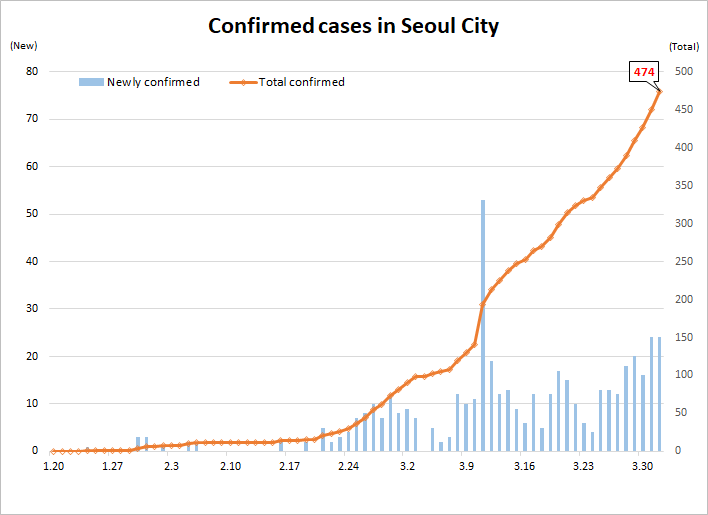
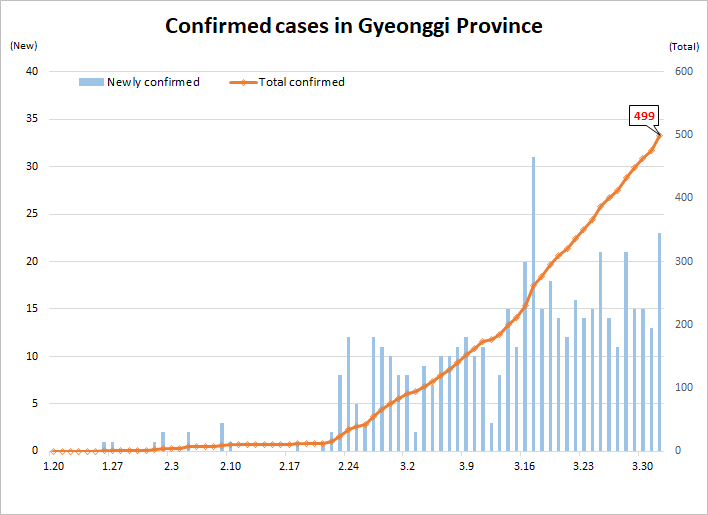
[Table 5: Case distribution by gender and age group]
|
|
Confirmed Cases |
(%) |
Deaths |
(%) |
Fatality rate (%) |
|
|
Total |
9,887 |
(100) |
165 |
(100) |
1.67 |
|
|
Sex |
Male |
3,946 |
(39.91) |
84 |
(50.91) |
2.13 |
|
Female |
5,941 |
(60.09) |
81 |
(49.09) |
1.36 |
|
|
Age |
80 and above |
452 |
(4.57) |
84 |
(50.91) |
18.58 |
|
70-79 |
658 |
(6.66) |
46 |
(27.88) |
6.99 |
|
|
60-69 |
1,245 |
(12.59) |
23 |
(13.94) |
1.85 |
|
|
50-59 |
1,865 |
(18.86) |
10 |
(6.06) |
0.54 |
|
|
40-49 |
1,323 |
(13.38) |
1 |
(0.61) |
0.08 |
|
|
30-39 |
1,027 |
(10.39) |
1 |
(0.61) |
0.10 |
|
|
20-29 |
2,682 |
(27.13) |
0 |
(0.00) |
- |
|
|
10-19 |
519 |
(5.25) |
0 |
(0.00) |
- |
|
|
0-9 |
116 |
(1.17) |
0 |
(0.00) |
- |
|
[Figures 8-9: Case distribution by gender and age group]
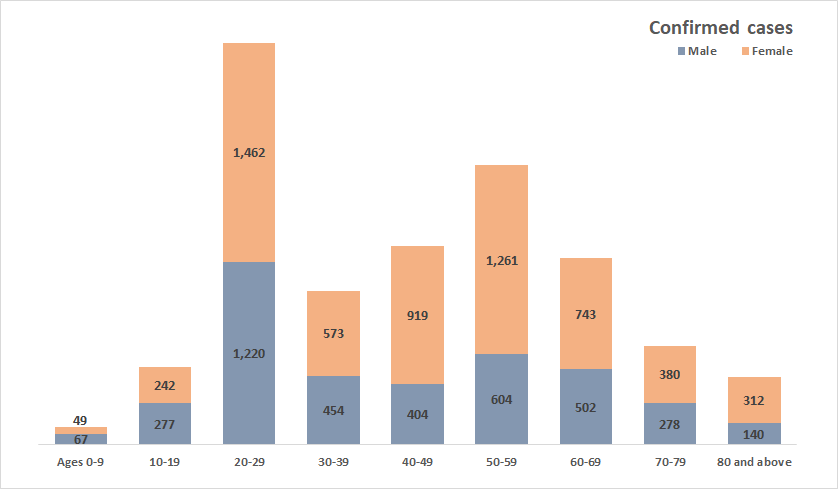
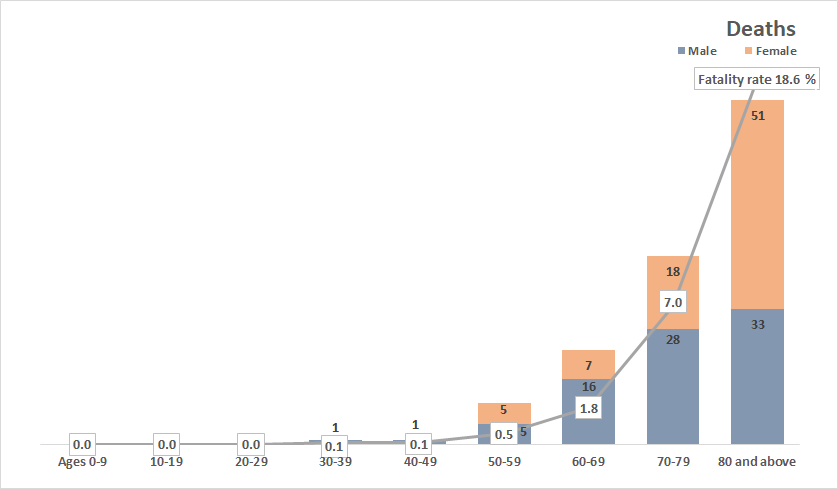
[Table 6: Age distribution of severe cases]
|
Age group |
Total |
Severe |
( |
% |
) |
Very severe |
( |
% |
) |
|
Total |
76 |
25 |
( |
100.0 |
) |
51 |
( |
100.0 |
) |
|
80 and above |
18 |
11 |
( |
44.0 |
) |
7 |
( |
13.7 |
) |
|
70-79 |
28 |
7 |
( |
28.0 |
) |
21 |
( |
41.2 |
) |
|
60-69 |
19 |
4 |
( |
16.0 |
) |
15 |
( |
29.4 |
) |
|
50-59 |
8 |
3 |
( |
12.0 |
) |
5 |
( |
9.8 |
) |
|
40-49 |
2 |
0 |
( |
0.0 |
) |
2 |
( |
3.9 |
) |
|
30-39 |
0 |
0 |
( |
0.0 |
) |
0 |
( |
0.0 |
) |
|
20-29 |
1 |
0 |
( |
0.0 |
) |
1 |
( |
2.0 |
) |
|
10-19 |
0 |
0 |
( |
0.0 |
) |
0 |
( |
0.0 |
) |
|
0-9 |
0 |
0 |
( |
0.0 |
) |
0 |
( |
0.0 |
) |
[Figure 10: Incidence rate by age group (per 100,000)]
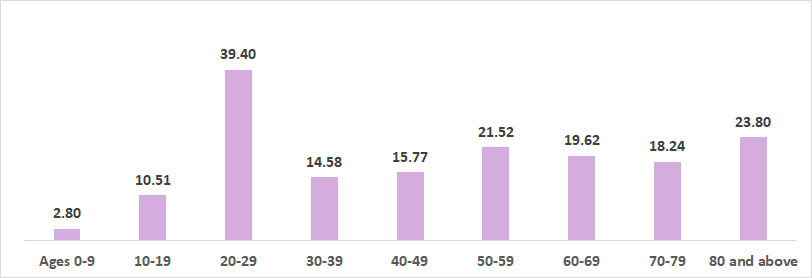
[Figure 11: Weekly trend of imported cases]
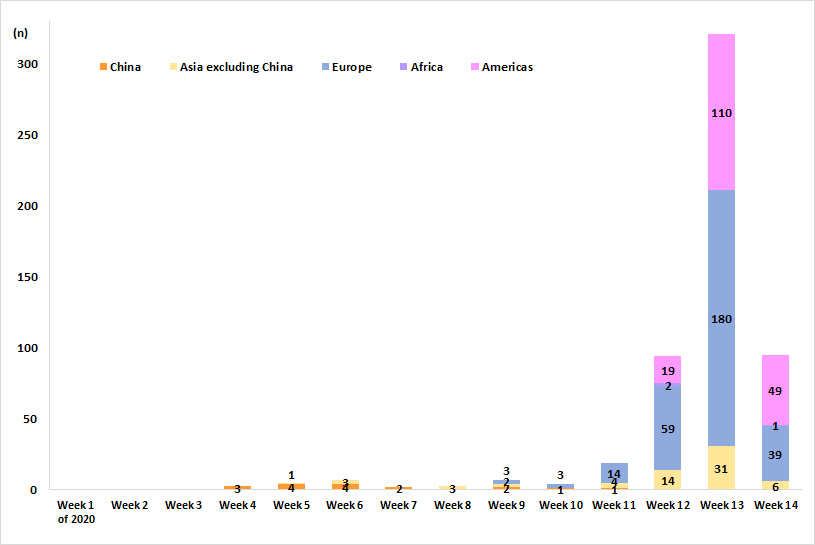
 This public work may be used under the terms of the public interest source + commercial use prohibition + nonrepudiation conditions
This public work may be used under the terms of the public interest source + commercial use prohibition + nonrepudiation conditions